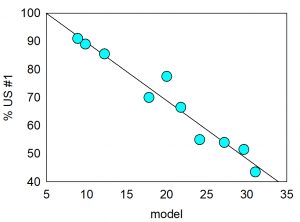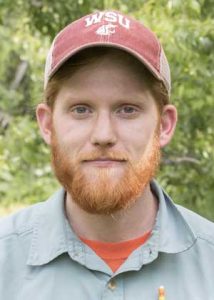Summary of WSDA project for growers. By Tianna DuPont, Chris Strohm, WSU Extension; Louis Nottingham, WSU Entomology; Dalila Rendon, OSU Entomology. Oct 2020. Printable Bio-based IPM.
Pear insect management is expensive in the Wenatchee River Valley, upwards of $1,000 per acre in the grower sites we are working with. At the same time, we are not always getting great control. In 2017 growers and consultants told us: “Each year the costs to achieve control of psylla grow and the control worsens,” “With increased resistance we need to look for a long-term alternative.” In response in 2017, we formed a Pear IPM team with researchers Betsy Beers and Louis Nottingham and acquired grant funding from WSDA’s Specialty Crop Block grant to compliment Washington State Tree Fruit Research Commission projects managed by Beers. Here I’ll summarize the WSDA project just completed this fall. Our goal is to identify IPM programs that work. We hypothesized that by identifying selective Biologically Based IPM programs that conserve natural enemies we could achieve season-long control, comparable packouts, with fewer spray costs. So far Bio-based IPM increased natural enemy populations and kept psylla numbers low through the end of the season. However, fruit marking was variable with good packouts in some Bio-based IPM plots and low packouts in others. Honeydew washing may be key to making Bio-based IPM consistent. Check out our new publication in Biological Control.

Who are the Natural Enemies in Pear Orchards?
Every week from April to October our team scouted twenty pear orchards from Monitor to Leavenworth, counting numbers of natural enemies, psylla, and mites. There are a few all-star natural enemies that we saw in many of the pear orchards – Deraeocoris, Campyloma, Trechnites, and Lacewings.
Deraeocoris brevis is a small black true bug, about one-third the width of a penny. These predators eat soft-bodied insects including spider mites, pear psylla, and mealybugs by using their piercing mouthparts to suck the insides out of their prey. One young Deraeocoris can eat 400 pear psylla eggs before it becomes an adult. We began seeing overwintering adults in beat trays and traps when we started scouting in early April and nymphs a few weeks later. From June until the end of the season we found both adults and nymphs in beat trays in orchards with IPM or Organic management. In one orchard we counted a Deraeocoris in every beat tray sample during the peak of the season.

Campylomma verbasci is considered a pest in apples, but in pears, growers think they may have the most potential for keeping psylla in check. A single Campylomma can eat 600 psylla eggs during development. We saw nymphs starting around pear bloom and documented three generations.
Trechnites insidiosus is an important parasitoid of pear psylla. For example, in previous studies, they have parasitized half of psylla nymphs in IPM systems. In the current study during bloom, populations skyrocketed up to 133 per sticky card trap in some blocks. Second and third generations were in early June and August to September.

Earwigs were uncommon in this study, found only in organic orchards, even though researchers think they are important. With only one generation per year and being a non-flyer, if their population is knocked back by pesticides it can take them a long time to recolonize orchards.

Lacewings. Both brown and green lacewings are considered important natural enemies. Known as ‘aphid lions’, the larvae are great predators of soft-bodied insects like psylla. Interestingly, lacewing adults were found in conventional as well as organic and IPM systems, but the predacious larvae were only numerous in organic and IPM blocks.
Do Bio-Based IPM Programs Conserve Natural Enemies?
We asked growers to use an IPM toolbox that avoided products with known negative impacts in five five-acre blocks we call Bio-based IPM and compared them to conventional and organic blocks clustered in close proximity. Bio-based IPM programs generally started with two to three applications of a kaolin clay like Surround followed by an IGR like Esteem. During the summer Bio-based IPM programs looked similar to organic with oils, neem products, and essential oils. Success! Bio-based IPM programs had higher natural enemy populations, with numbers similar to organic orchards (Figure 5). Surprisingly natural enemy communities bounced back even in the first year of transition in some blocks.

The Bottom Line – Psylla Numbers, Fruit Quality and Returns
In IPM programs, similar to organic, psylla nymph numbers and honeydew stayed lower all the way to the end of the season. Often, we see a spike in psylla numbers in the late season when coverage in large pear canopies is difficult. We hypothesized that if we could conserve natural enemies, they would do the work for us late season. Both psylla adult and nymph populations increased greatly in the last seven weeks of the season in conventional plots compared to organic and IPM plots with an average of 17 psylla adults per tray in conventional compared to 4 in organic (P=0.004) and 6 in IPM (P=0.0024) and 9 psylla nymphs per leaf in conventional compared to 3 in organic (P<0.001) and 4 in IPM (P=0.004). At the week 20 peak, conventional plots had 14 nymphs per leaf while organic and IPM plots had just 4-5 nymphs per leaf. In 2019, the worst psylla year of the project, the late-season differences were particularly pronounced (Figure 6). So, check box 1 – Yes Bio-based IPM kept late-season populations from skyrocketing.

Bio-based IPM programs were also successful in keeping late-season honeydew low. We measured honeydew at Bartlett and D’Anjou harvest timing by removing 100 leaves per block (10 trees), rinsing the leaves, and measuring the degrees Brix. In 2018 and 2019 by d’ Anjou harvest leaves (and fruit) were stickier in the conventional blocks we tracked (significantly greater than IPM and organic plots in 2019 P <0.001) (Figure 7).

However, the bottom line is fruit quality and returns. We graded fruit from 20 randomly selected trees in each site close to harvest (10 fruit per tree). We categorized fruit as either U.S. #1, Washington Fancy, or Cull based on USDA packing grades for honeydew marking (pear psylla and mealybug). We also looked at packing house data but our field checks allowed us to look specifically at insect-related marking more precisely. While psylla and honeydew were low late season in 2019 a population spike in late June – early July before natural enemy populations established for the year resulted in significant marking in organic and bio-based IPM plots in 2019 (Figure 8). On average, 2018 packouts were 84% US#1 in IPM, significantly lower than 96% in Conventional with organic intermediate at 90%. In 2019, 71% US#1 in IPM was not significantly different than 81% in Conventional which was significantly higher than 61% in organic. Interestingly while marking was high and packouts low in some IPM plots (e.g. 44% US#1 in site 1) in other IPM plots marking was quite low (e.g. 80% US#1 site 5 compared to 80% conventional counterpart and site 15 86% US #1 versus to 89% conventional).


When can Bio-Based IPM programs be successful?
We did an analysis that looks at the importance of multiple factors (multiple regression) to the packout for the IPM and organic blocks in 2019 to look at what might be making some programs that rely on natural enemies from marking fruit and others do not. The analysis found that natural enemies early summer and at harvest as well as tree size, number of honeydew washes, and the score of the spray program were important. Interestingly the amount of pear cover in the surrounding area was not significant in this analysis. To make bio-based IPM consistently successful we may need to incorporate honeydew washing systems.
Developing a scorecard
In order to make management decisions about when to spray and when natural enemies will be able to keep pest populations under control, we are developing a scorecard. We are looking at the relationship between numbers of natural enemies in the block, numbers of pests (psylla nymphs), honeydew, and ultimate packouts. Current analysis shows that 1:1 psylla nymphs: natural enemies per tray early season and 3:1 psylla nymphs: natural enemies per tray near to harvest are thresholds we don’t want to exceed in order to keep honeydew under control.
Where do we go from here?
We feel confident that bio-based IPM programs can conserve natural enemy populations and that those populations can help keep psylla and honeydew numbers down in the critical late-season period. But before growers can feel confident, we need to test our natural enemy scorecard so that growers can make in-season responses immediately when natural enemy to pest population ratios are above the threshold. Working with Nottingham’s team we will also be exploring honeydew washing systems which can provide a measure of insurance for IPM programs when things get sticky.
For more information
https://treefruit.wsu.edu/crop-protection/pear-ipm/
DuPont, S.T. Strohm, C., Nottingham, L, Rendon, D. Evaluation of an integrated pest management program for central Washington pear orchards. Biological Control. 2021.152: 104390
DuPont ST, John Strohm C. Integrated pest management programs increase natural enemies of pear psylla in Central Washington pear orchards. J Appl Entomol. 2020;144:109–122. Downloadable at https://treefruit.wsu.edu/tianna-dupont/
Thank you to WSDA Specialty Crop Block Grant # K1986.
Use pesticides with care. Apply them only to plants, animals, or sites listed on the labels. When mixing and applying pesticides, follow all label precautions to protect yourself and others around you. It is a violation of the law to disregard label directions. If pesticides are spilled on skin or clothing, remove clothing, and wash skin thoroughly. Store pesticides in their original containers and keep them out of the reach of children, pets, and livestock.
YOU ARE REQUIRED BY LAW TO FOLLOW THE LABEL. It is a legal document. Always read the label before using any pesticide. You, the grower, are responsible for safe pesticide use. Trade (brand) names are provided for your reference only. No discrimination is intended, and other pesticides with the same active ingredient may be suitable. No endorsement is implied.
Contact
 Tianna Dupont
Tianna Dupont
WSU Tree Fruit Extension Specialist
(509) 293-8758
tianna.dupont@wsu.edu
 Chris Strohm
Chris Strohm
WSU Extension Assistant
(509) 293-8792
chris.strohm@wsu.edu
treefruit.wsu.edu articles may only be republished with prior author permission © Washington State University. Republished articles with permission must include: “Originally published by Washington State Tree Fruit Extension at treefruit.wsu.edu” along with author(s) name, and a link to the original article.
